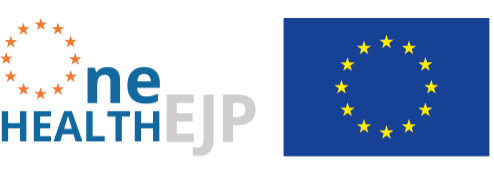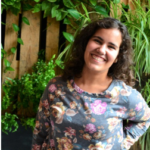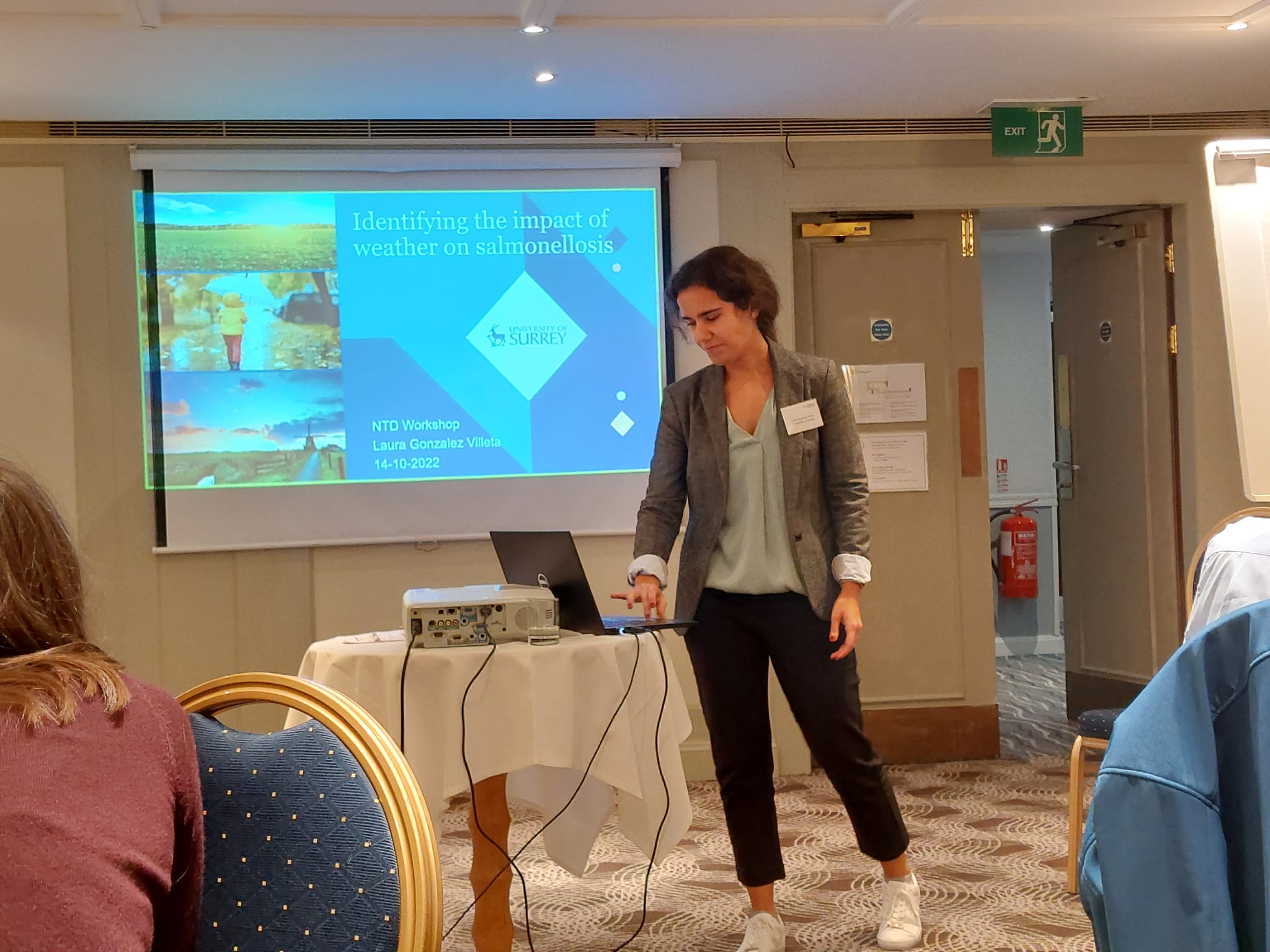Leatherhead, England, United Kingdom
133 Waterloo Road, London Borough of Lambeth, England, United Kingdom
Daphne Jackson Road, Guildford, England, United Kingdom

The Project #ENVDIS
| Start: | January 2020 |
| Duration: | 3 years |
| Domain: | Foodborne Zoonoses |
| Members: | University of Surrey- UK, PHE- UK |
| Contact: | Dr Giovanni Lo Iacono |
EnvDis: Environment and Diseases: Modelling the influence of weather in salmonellosis
Salmonella remains an important causative agent of diarrhoeal diseases worldwide, being the pathogen most frequently involved in food-borne outbreaks. Around 90,000 salmonellosis cases are reported in the European Union every year, with a substantial economic and social impact. Although symptoms are usually mild, complications leading to invasive and serious bacteremia are estimated in up to 5% of cases.
The number of infections is expected to change with population growth and increasing antibiotic resistance. Furthermore, anthropogenic activities are constantly changing the environment, which is a well-recognized driver of diseases. The environment includes weather, climate, land use and socio-economic factors that may affect pathogen abundance, survival, and virulence, host susceptibility to infection, as well as human behaviour. It is believed that the accelerating rate of change in the global climate and environment will impact the distribution, frequency and patterns of established diseases as well as the emergence and re-emergence of new and old ones. As a society, it is our duty to be prepared.
Our mathematical model was designed to understand the effect of weather on salmonellosis infections in humans, contributing to the understanding on the effect of weather as modulator of disease. This method allows quantification of the prevalence of salmonellosis for a particular subset of weather conditions, which can be interpreted as the daily probability of acquiring the disease conditional on the weather variables. Here and throughout, by conditional prevalence we refer to the daily probability multiplied by million (i.e., the daily number of cases per million).
A definite version of the model object of this PhD project was finalised after exploring various weather variables. The weather variables were chosen according to their potential influence over bacterial growth, especially in the last step of the food chain for human consumption (i.e., from purchase to consumption), which include maximum and mean air temperature, temperature variation, dewpoint temperature, air pressure, mean and cumulative precipitation, relative humidity, sunshine duration, global radiation, and daylength. Because weather has a complex, non-linear and potentially inter-connected association with infection, the effect of three different and stratified variable combinations were explored. From the preliminary results, we can conclude that the risk of contracting salmonellosis rising with air temperature (peaking at around 15-19 ºC), depending on the length of the day.
The number of cases can be inferred as a Poisson process with a rate given by the product of i) the number of residents in a catchment area and ii) the conditional prevalence corresponding to the local weather variables. The modelled cases were validated by visually comparing the simulations with historical infection data in England and Wales for the years 1989-2016. Maximum air temperature, relative humidity, precipitation, and global radiation are the variables that compare more favourable with the empirical data, implying that they might have a more relevant role in driving salmonellosis risk of infection. These findings are currently being adjusted for a closer fit by using a spline detrend method of the cases. This corrects for the temporal variability in the magnitude of cases recorded of long time series following the implementation of various control measures in poultry farming (e.g., movement restrictions, compulsory slaughter and disinfection procedures, as well as a vaccination scheme that began in breeding flocks in 1994 and in laying flocks in 1998).
A short-term mission was carried out to evaluate the hypothesis that the effect of weather on salmonellosis cases is universal and not specific to geographical location. For this, the historical epidemiological and meteorological data of the Netherlands were compared to the simulated cases based on the conditional prevalence built upon British data. The model can identify the main summer peak, but it still shows some slight discrepancies with the empirical data, namely the theoretical predictions present a minor peak in April-May that were not observed in the surveillance data. This is probably due to a human component inherent to the country’s data or perhaps the combination of the chosen explanatory environmental variables needs to be revised.
We also applied the methodology to the worst-case scenario (RCP 8.5) of the climate change projections for England and Wales to explore the state of salmonellosis in a near future, where no significant change of human behaviour or additional mitigating measures are assumed against Salmonella. According to our preliminary results, a potential flattening effect in the incidence curve could be expected by the year 2043, with higher number of cases in the first half of the year and a less severe summer peak. These findings are currently being revised and yet to be confirmed.
Project Assets
“Enrich your research profile with an experience abroad.” Oral presentation. OHEJP Final School, online. 5-7th December 2022.
Poster presentation at Postgraduate Researcher Showcase – Building Connections, Doctoral College and Surrey Research Park, UK. 30th November 2022.
Oral presentation on the latest findings on my project. The Neglected Tropical Diseases (NTD) workshop, Brighton, UK. 14th October 2022.
Poster presentation at ONE conference organised by EFSA, Brussels, Belgium. 21-24th June 2022. Further details in report.
Oral presentation at Journal Club to the Gastrointestinal Diseases team while visiting the RIVM, the Netherlands. 10th May 2022.
Poster presentation at OHEJP Annual Scientific Meeting, Orvieto, Italy. 11-13th April 2022. Further details in report.
Poster presentation at inaugural Open Research Lecture: challenges of Open research, University of Surrey, UK. 8th April 2022. Further details in report.
“Ongoing progress in the understanding of the environmental drivers of human salmonellosis using modelling.” Oral presentation. Modelling in Animal Health conference (ModAH2), online. 16th September 2021. Further details in report.
Poster presentation at OHEJP Annual Scientific Meeting, hybrid event. 9-11th June 2021. Further details in report.
Project progress video presentation as part of the Veterinary Health Innovation Engine group (vHIVE). Oral presentation. 6th World One Health Congress, online. 30th October to 3rd November 2020. Further details in report.
Poster presentation at 6th World One Health Congress, online. 30th October to 3rd November 2020. Further details in report.
Oral presentation at University of Surrey School of Veterinary Medicine Research Celebration Event, online. 9th September 2020. Further details in report.
3-minute Thesis Competition, Oral presentation at University of Surrey, Doctoral College, 1st June 2020 and OHEJP Annual Scientific meeting, online, 27-29th May 2020. Further details in report.
Poster presentation at OHEJP Annual Scientific meeting, online. 27-29th May 2020. Further details in report.




